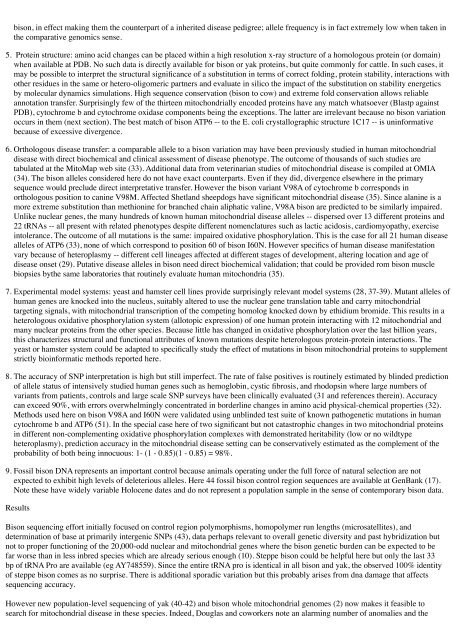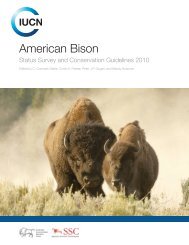Declaration Dr. Thomas H. Pringle - Buffalo Field Campaign
Declaration Dr. Thomas H. Pringle - Buffalo Field Campaign
Declaration Dr. Thomas H. Pringle - Buffalo Field Campaign
You also want an ePaper? Increase the reach of your titles
YUMPU automatically turns print PDFs into web optimized ePapers that Google loves.
ison, in effect making them the counterpart of a inherited disease pedigree; allele frequency is in fact extremely low when taken in<br />
the comparative genomics sense.<br />
5. Protein structure: amino acid changes can be placed within a high resolution x-ray structure of a homologous protein (or domain)<br />
when available at PDB. No such data is directly available for bison or yak proteins, but quite commonly for cattle. In such cases, it<br />
may be possible to interpret the structural significance of a substitution in terms of correct folding, protein stability, interactions with<br />
other residues in the same or hetero-oligomeric partners and evaluate in silico the impact of the substitution on stability energetics<br />
by molecular dynamics simulations. High sequence conservation (bison to cow) and extreme fold conservation allows reliable<br />
annotation transfer. Surprisingly few of the thirteen mitochondrially encoded proteins have any match whatsoever (Blastp against<br />
PDB), cytochrome b and cytochrome oxidase components being the exceptions. The latter are irrelevant because no bison variation<br />
occurs in them (next section). The best match of bison ATP6 -- to the E. coli crystallographic structure 1C17 -- is uninformative<br />
because of excessive divergence.<br />
6. Orthologous disease transfer: a comparable allele to a bison variation may have been previously studied in human mitochondrial<br />
disease with direct biochemical and clinical assessment of disease phenotype. The outcome of thousands of such studies are<br />
tabulated at the MitoMap web site (33). Additional data from veterinarian studies of mitochondrial disease is compiled at OMIA<br />
(34). The bison alleles considered here do not have exact counterparts. Even if they did, divergence elsewhere in the primary<br />
sequence would preclude direct interpretative transfer. However the bison variant V98A of cytochrome b corresponds in<br />
orthologous position to canine V98M. Affected Shetland sheepdogs have significant mitochondrial disease (35). Since alanine is a<br />
more extreme substitution than methionine for branched chain aliphatic valine, V98A bison are predicted to be similarly impaired.<br />
Unlike nuclear genes, the many hundreds of known human mitochondrial disease alleles -- dispersed over 13 different proteins and<br />
22 tRNAs -- all present with related phenotypes despite different nomenclatures such as lactic acidosis, cardiomyopathy, exercise<br />
intolerance. The outcome of all mutations is the same: impaired oxidative phosphorylation. This is the case for all 21 human disease<br />
alleles of ATP6 (33), none of which correspond to position 60 of bison I60N. However specifics of human disease manifestation<br />
vary because of heteroplasmy -- different cell lineages affected at different stages of development, altering location and age of<br />
disease onset (29). Putative disease alleles in bison need direct biochemical validation; that could be provided rom bison muscle<br />
biopsies bythe same laboratories that routinely evaluate human mitochondria (35).<br />
7. Experimental model systems: yeast and hamster cell lines provide surprisingly relevant model systems (28, 37-39). Mutant alleles of<br />
human genes are knocked into the nucleus, suitably altered to use the nuclear gene translation table and carry mitochondrial<br />
targeting signals, with mitochondrial transcription of the competing homolog knocked down by ethidium bromide. This results in a<br />
heterologous oxidative phosphorylation system (allotopic expression) of one human protein interacting with 12 mitochondrial and<br />
many nuclear proteins from the other species. Because little has changed in oxidative phosphorylation over the last billion years,<br />
this characterizes structural and functional attributes of known mutations despite heterologous protein-protein interactions. The<br />
yeast or hamster system could be adapted to specifically study the effect of mutations in bison mitochondrial proteins to supplement<br />
strictly bioinformatic methods reported here.<br />
8. The accuracy of SNP interpretation is high but still imperfect. The rate of false positives is routinely estimated by blinded prediction<br />
of allele status of intensively studied human genes such as hemoglobin, cystic fibrosis, and rhodopsin where large numbers of<br />
variants from patients, controls and large scale SNP surveys have been clinically evaluated (31 and references therein). Accuracy<br />
can exceed 90%, with errors overwhelmingly concentrated in borderline changes in amino acid physical-chemical properties (32).<br />
Methods used here on bison V98A and I60N were validated using unblinded test suite of known pathogenetic mutations in human<br />
cytochrome b and ATP6 (51). In the special case here of two significant but not catastrophic changes in two mitochondrial proteins<br />
in different non-complementing oxidative phosphorylation complexes with demonstrated heritability (low or no wildtype<br />
heteroplasmy), prediction accuracy in the mitochondrial disease setting can be conservatively estimated as the complement of the<br />
probability of both being innocuous: 1- (1 - 0.85)(1 - 0.85) = 98%.<br />
9. Fossil bison DNA represents an important control because animals operating under the full force of natural selection are not<br />
expected to exhibit high levels of deleterious alleles. Here 44 fossil bison control region sequences are available at GenBank (17).<br />
Note these have widely variable Holocene dates and do not represent a population sample in the sense of contemporary bison data.<br />
Results<br />
Bison sequencing effort initially focused on control region polymorphisms, homopolymer run lengths (microsatellites), and<br />
determination of base at primarily intergenic SNPs (43), data perhaps relevant to overall genetic diversity and past hybridization but<br />
not to proper functioning of the 20,000-odd nuclear and mitochondrial genes where the bison genetic burden can be expected to be<br />
far worse than in less inbred species which are already serious enough (10). Steppe bison could be helpful here but only the last 33<br />
bp of tRNA Pro are available (eg AY748559). Since the entire tRNA pro is identical in all bison and yak, the observed 100% identity<br />
of steppe bison comes as no surprise. There is additional sporadic variation but this probably arises from dna damage that affects<br />
sequencing accuracy.<br />
However new population-level sequencing of yak (40-42) and bison whole mitochondrial genomes (2) now makes it feasible to<br />
search for mitochondrial disease in these species. Indeed, Douglas and coworkers note an alarming number of anomalies and the










